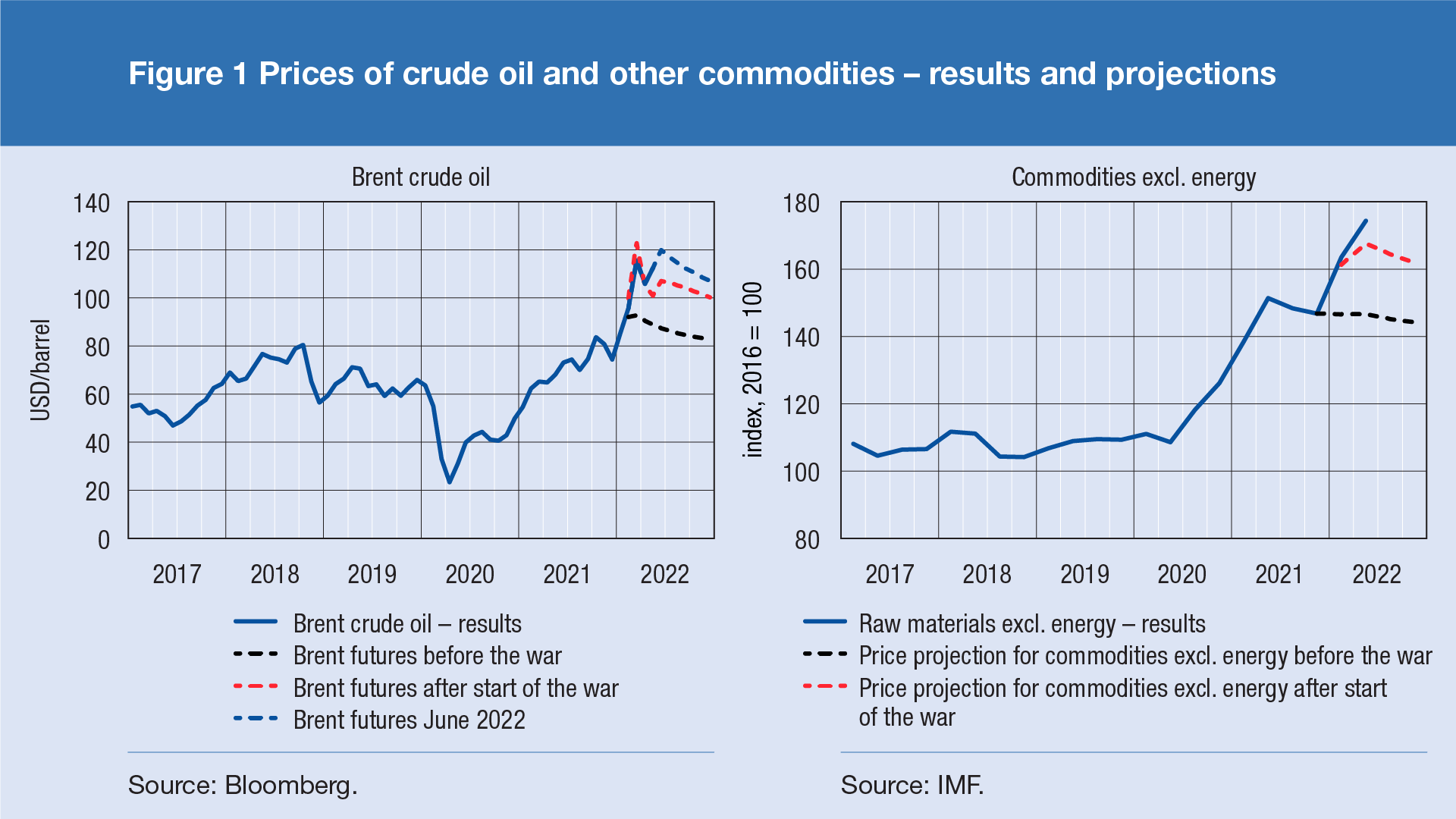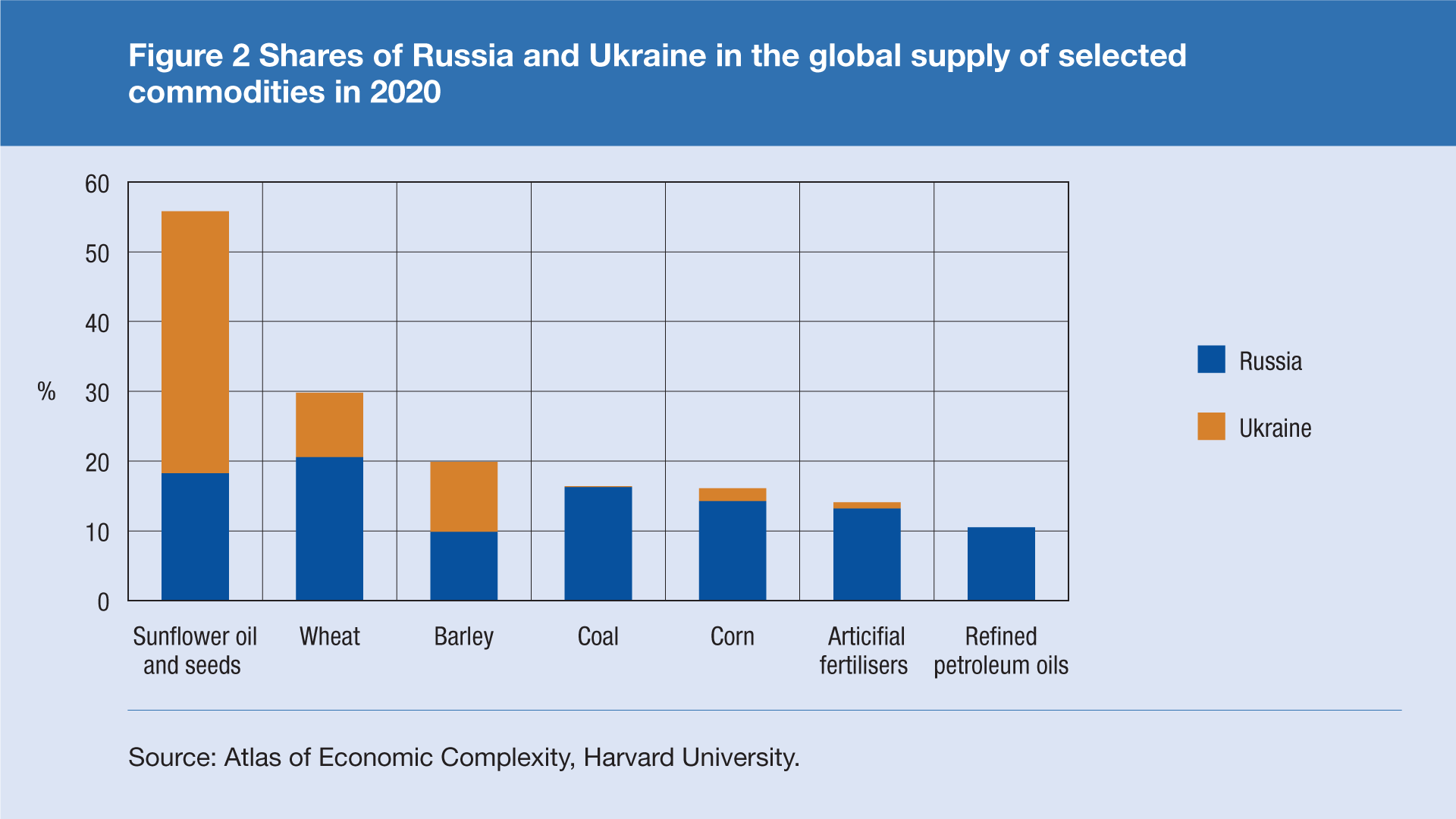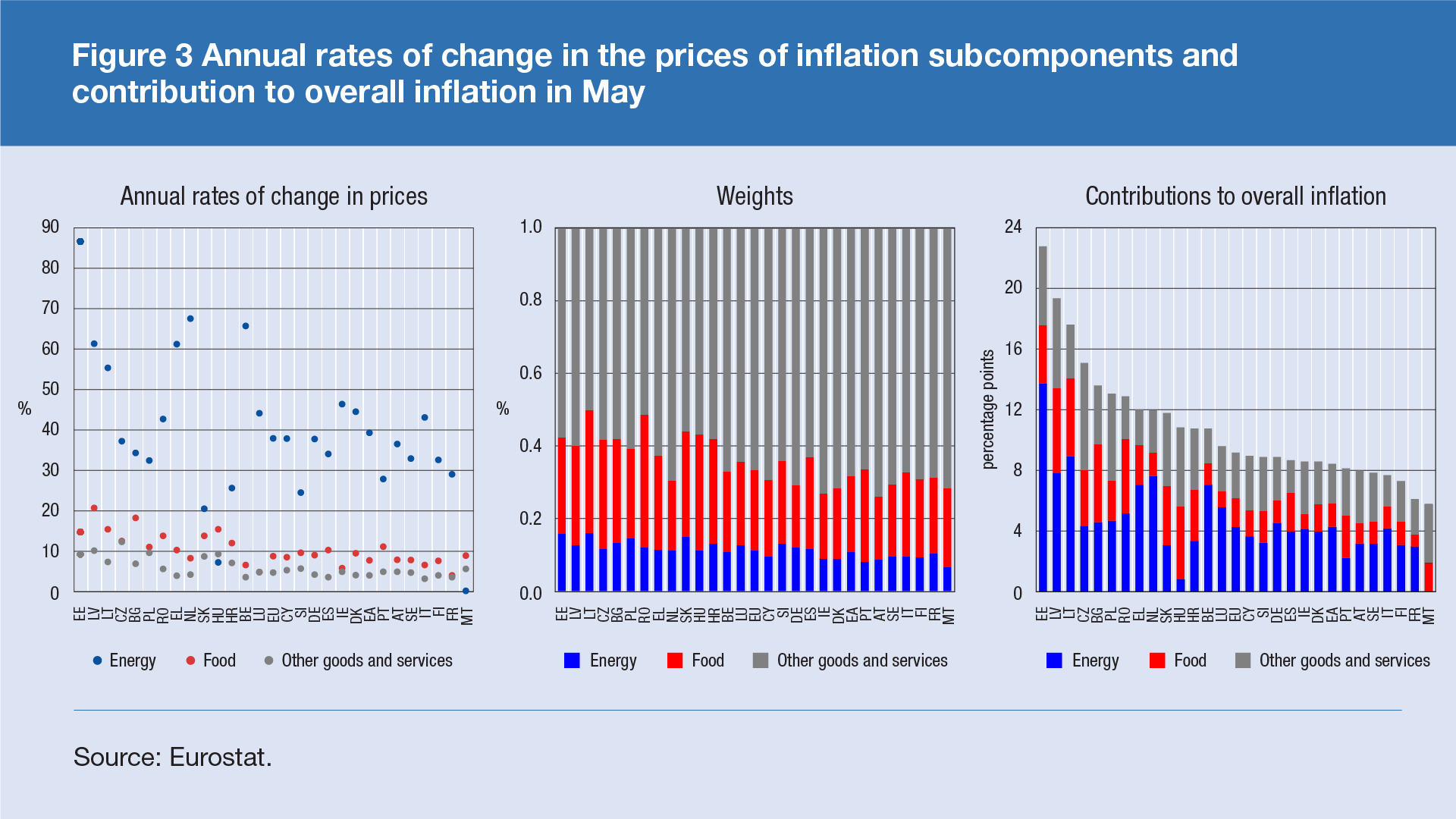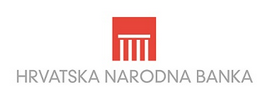However, war-induced production and trade constraints affecting the world market supply of some commodities, increasingly more severe sanctions imposed on Russia and the ongoing high uncertainty surrounding the course and duration of the war have boosted the prices of energy products and other commodities. The Russian invasion has thus built on and intensified the consumer price inflation growth trend, recorded by many countries since the middle of the previous year. Gas prices in the European market had increased a few months before the war broke out due to a drop in the supply of gas, Russian gas in particular, and depleted gas reserves. Upward pressures on oil prices have picked up since the outbreak of the conflict and the prices of some food raw materials and metals supplied to the world market by Russia and Ukraine have risen. The markets' reaction to the war almost instantly increased the assessment of average consumer price inflation, while the disturbances keeping the prices of energy products and commodities high and pushing them higher are escalating as the war continues and causes further market disruption and as the new rounds of sanctions on Russia are imposed.
The recent acceleration of consumer price inflation has to some extent been affected by the war in Ukraine, primarily because it is boosting the prices of energy products and food raw materials. Natural gas prices in the European market had risen sharply before the war broke out due to a lower than usual supply of gas, Russian gas in particular, and the consequent depletion of gas reserves, and crude oil prices have also increased further since the beginning of the war (Figure 1 Prices of crude oil and other commodities – results and projections). The prices of a number of other commodities (especially food raw materials) supplied by Russia and Ukraine to the world market have also increased since the end of February 2022. Russia and Ukraine are major global producers and exporters of sunflower, i.e., of sunflower oil, wheat, barley, corn, and coal and oil as energy products, as well as of artificial fertilisers, an important input component in the production of a large number of food products (Figure 2 Shares of Russia and Ukraine in the world supply of selected commodities in 2020). The war-induced reduction in the supply of these products has led to a sharp increase in global food raw materials' prices. Furthermore, Russia exploits large deposits of metal ores and supplies iron, steel and non-ferrous metals to a large number of countries. Due to a drop in the supply of these commodities brought about by sanctions, which have weighted down on trade and payment operations with Russia, and the ban on Russian exports of some commodities, global metal prices have skyrocketed since the beginning of the war.


The world market prices of commodities that can be linked to the war in Ukraine had an almost immediate effect on consumer price inflation in the whole of Europe, including Croatia. Commodity price assumptions, an important element of inflation projections, have worsened considerably after the start of the conflicts. The projected growth of oil prices for 2022 doubled immediately after the beginning of the Russian invasion of Ukraine (up from 25% to 50% annually) and the expected price growth of other commodities also accelerated (from 0% to 11% annually). If we include new assumptions on the prices of energy products and other commodities in standard projection models, we can assess the current (immediate) effect of the war in Ukraine, evident in the growth of prices after the start of the invasion from the price level immediately before it, on average annual consumer price inflation in 2022 as being slightly lower than 1 percentage point. The strongest assessed effect is that on the average annual growth of energy prices, which increases immediately by 1.5 percentage points, while the assessed effect on the average annual growth of food prices is about 1 percentage point. However, gas prices had increased even before the outbreak of the war, while the prices of oil and other commodities continued to grow after the outbreak, rising more than initially expected, so that the overall effect on consumer price inflation is likely to be even higher.
War-induced increases in the prices of energy products, food raw materials and other commodities in the world market have been spilling over with various intensity to consumer price inflation in the whole of Europe. Increases in the prices of food and other commodities, as well as of energy products, have built on and strengthened the inflation acceleration trend, started in the middle of the previous year due to supply chain disruptions and the growth of demand caused by the reopening of the economy. The impact of the war-related increase in energy prices on consumer prices in Croatia is less pronounced than in most other countries in the European Union, which is on the one hand due to Croatia's lower dependence on the imports of energy and other commodities from Russia and Ukraine compared with these countries and, on the other hand, to a specific model of their administrative regulation. In contrast, the growth of food prices in Croatia has exceeded the average growth in EU member states, while remaining in line with trends in Central and Eastern European countries. This is a consequence of a relatively large share of food in the consumer basket used for the calculation of inflation in Central and Eastern Europe and a slightly higher increase in these prices (Figure 3 Annual rates of change in the prices of inflation subcomponents and contribution to overall inflation).

The effects of the war in Ukraine on the world market prices of energy products and other commodities have increased since the war's outbreak, with the risks of the further growth of prices that depend on its course and duration and potential new sanction packages still present. The recent indicators of developments in commodities' prices in the world market point to a gradual normalisation of these prices following their sharp increase, which in some segments continued after the beginning of the war. For that reason, the CNB has also revised its inflation projections several times since the outbreak of the war, currently expecting average inflation for 2022 to exceed 9%. According to commodities' prices in forward markets (where traders buy and sell commodities at prices agreed on the trade date and with delivery at a future date, for example in six months or a year), commodities' prices are expected to drop gradually towards the end of the projection horizon. However, as the war continues, disturbances in the supply of war-affected areas escalate, while potential new sanctions could further reduce the supply of commodities exported by Russia and trigger further growth of prices in the world market. The realisation of the current inflation projection is therefore still exposed to considerable risks.
